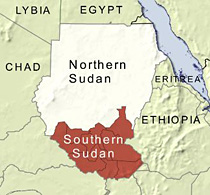Nairobi
29 July 2009
 |
| Northern and Southern Sudan |
The report focuses on what Jane's Defense Weekly says is South Sudan's on-going attempt to assemble a significant fleet of main battle tanks, possibly with help from neighboring Kenya.
The author of the report, Lauren Gelfand, says her research tried to confirm reports that a shipment of 33 Russian style T-72 tanks, weapons and ammunition captured by Somali pirates a year ago aboard the Ukrainian freighter MV Faina and later released to the Kenyan government, were destined for South Sudan.
The Kenyan government has long insisted that it purchased the consignment of arms for the Kenyan army and officials in South Sudan have repeatedly denied any involvement.
Gelfand says that while she could not prove the tanks aboard the Faina are now in South Sudan, satellite imagery gathered between March and May of this year showed nearly two dozen new tracked vehicles under camouflage at a compound belonging to the Sudan People's Liberation Army. Gelfand says the size and dimensions suggests the vehicles are not the older and smaller T-54 and T-55 tanks, but more modern T-72s. Gelfand says Jane's Defense Weekly has confirmed from sources that South Sudan ordered 100 T-72 tanks as early as 2005.
"The T-72s that South Sudan said they did not order, the ones aboard the Faina, are the third of three shipments that had been ordered around the time the SPLM signed the CPA with the Khartoum government," said Lauren Gelfand. "It fits within the broader context that even though they did sign this peace agreement, they still have an enduring disenchantment with one another and an enduring difficulty in really coming together and being one country."
South Sudan officials had no immediate comment on the Janes Report.
The Comprehensive Peace Agreement, also known as CPA, was signed in 2005, ending one of Africa's most devastating civil wars. The final death toll reached two million and another four million people were internally uprooted.
The CPA attempted to address the core issues that led to the conflict, namely complaints by the South that it was being politically and economically marginalized by Khartoum's northern Arab-dominated government. Through the CPA, the former adversaries agreed to share power and oil wealth and to allow South Sudan to conduct a referendum on independence in 2011.
But amid on-going disputes about territorial claims and oil rights, the accord has largely failed to unify the two sides. Instead, analysts say both the North and South have tried to guarantee their positions by building up their armies.
Gelfand says the government in Khartoum, which is fighting a separate war in the western Darfur region, has been steadily modernizing its ground forces and significantly expanding its fleet of military aircraft.
"They confirmed last year that they bought a bunch of MiG-29 multi-role fighter aircraft and they also acquired Chinese aircraft," said Gelfand. "And Chinese technicians were allegedly seen in North Sudan helping to train Sudanese air force pilots because they just did not have the ability to fly these sophisticated aircraft. The MiG-29s that were part of the air fleet beforehand had been flown by Russians. But it seems like there might be a move toward having indigenously-trained pilots."
Khartoum also has attack helicopters, armed trainer aircraft, transport aircraft and a substantial arsenal of surface-to-air missiles, artillery, field guns, and advanced rocket systems.
Analysts say if the CPA collapses, Sudan can expect to return to full-scale war with better weaponry, more firepower, and more horrific loss of lives.